Abstract
Objective:
This study aimed to verify the intra-individual reproducibility of the natural head position (NHP) in adult Korean patients in the centric relation (CR) position and to prove the inter-individual variability of the Frankfurt horizontal (FH) plane and sella-nasion (SN) line compared to the true horizontal line (THL). In addition, the study aimed to investigate the correlations between linear measurements from A-point and B-point to the nasion true vertical line (NTVL) and angular measurements from A-point and B-point to the SN line.
Methods:
Two lateral cephalograms were taken of 116 subjects (23 males, 93 females) with CR wax bites in a NHP at a one-week interval.
Results:
Method errors of three variables and intraclass correlation coefficients of six parameters proved the intra-individual reproducibility of NHP (p < 0.001). The angle of the FH to the THL was not significantly different from 0° (p > 0.05), but it was clinically variable (SD 3.89°) on the inter-individual level. Conversely, the angle of the SN line to the THL was significantly different from 7° (p < 0.05). Very low correlation was found between the linear measurements and angular measurements of A-point and B-point (p < 0.01).
Go to : 
REFERENCES
1.Broadbent BH. A new X-ray technique and its application to orthodontia. Angle Orthod. 1931. 1:45–66.
2.Hofrath H. Die Bedeutung der Röntgenfern –und Abstand-saufnahme für die Diagnostik der kieferanomalien. Fortschritte der kieferorthopädie. 1931. 1:232–58.

3.Downs WB. Variations in facial relationships; their significance in treatment and prognosis. Am J Orthod. 1948. 34:812–40.

5.Riedel RA. Relation of maxillary structures to cranium in malocclusion and in normal occlusion. Angle Orthod. 1952. 22:142–45.
6.Tweed CH. The Frankfort-mandibular plane angle in orthodontic diagnosis classification, treatment planning, and prognosis. Am J Orthod Oral Surg. 1946. 32:175–230.

7.Tweed CH. The Frankfort-mandibular incisor angle (FMIA) in orthodontic diagnosis, treatment planning and prognosis. Angle Orthod. 1954. 24:121–69.
8.Ricketts RM. Cephalometric synthesis: An exercise in stating objectives and planning treatment with tracings of the head roentgenogram. Am J Orthod. 1960. 46:647–73.
9.Jenkins DH. Analysis of orthodontic deformity employing lateral cephalostatic radiography. Am J Orthod. 1955. 41:442–52.

12.Taylor CM. Changes in the relationship of nasion, point A, and point B and the effect upon ANB. Am J Orthod. 1969. 56:143–63.
13.Beatty EJ. A modified technique for evaluating apical base relationships. Am J Orthod. 1975. 68:303–15.

14.Broca M. Sur les projections de la tète, et sur un nouveau pro-cède de cephalometrié. Bull de la SociétéD'Anthropologie de Paris. 1862. 3:514–44.
15.Moorrees CFA., Kean MR. Natural head position: a basic consideration in the interpretation of cephalometric radiographs. Am J Phys Anthrop. 1958. 16:213–34.

16.Leitão P., Nanda RS. Relationship of natural head position to craniofacial morphology. Am J Orthod Dentofacial Orthop. 2000. 117:406–17.
17.Peng L., Cooke MS. Fifteen-year reproducibility of natural head posture: A longitudinal study. Am J Orthod Dentofacial Orthop. 1999. 116:82–5.

18.Choi BT. Articulator mounting. In: Choi BT editor. Steps of preparation for orthognathic surgery. Seoul: Jee sung;2004. p. 113–32.
19.Solow B., Tallgren A. Natural head position in standing subjects. Acta Odontol Scand. 1971. 29:591–607.

20.Dahlberg G. Statistical methods for medical and biological students. New York: Interscience Publications;1940.
21.Park EJ., Suhr CH. Study of craniocervical posture and craniofacial morphology in Korean young adults. Korean J Orthod. 1995. 25:129–42.
22.Lee CM., Cha KS. A study on the adaptation of the craniofacial structure to the variations of head postures. Korean J Orthod. 1992. 22:169–77.
23.Kim HR., Lee DY., Kim KW., Yoon YJ. A study on the reproducibility of the natural head position according to the skeletal malocclusion types and sex. Korean J Orthod. 2000. 30:307–15.
24.Hanau RL. Occlusal changes in centric relation. J Am Dent Assoc. 1929. 16:1903–15.
25.The glossary of prosthodontic terms. The Academy of Prosthodontics. J Prosthet Dent. 1994. 71:41–112.
26.Lundeen HC., Shryock EF., Gibbs CH. An evaluation of mandibular border movements: their character and significance. J Prosthet Dent. 1978. 40:442–52.

28.Dawson PE. Centric relation. In: Dawson PE editor. Evaluation, diagnosis, and treatment of occlusal problem. St Loius: CV Mosby;1974. p. 48–70.
29.Strohaver RA. A comparison of articulator mountings made with centric relation and myocentric position records. J Prosthet Dent. 1972. 28:379–90.

31.Dawson PE. Optimum TMJ condyle position in clinical practice. Int J Periodontics Restorative Dent. 1985. 5:10–31.
33.Huggare JA. A natural head position technique for radiographic cephalometry. Dentomaxillofac Radiol. 1993. 22:74–6.

34.Cooke MS., Wei SH. The reproducibility of natural head posture: a methodological study. Am J Orthod Dentofacial Orthop. 1988. 93:280–8.

35.Showfety KJ., Vig PS., Matteson S. A single method for taking natural head position cephalograms. Am J Orthod. 1983. 83:495–500.
36.Bjerin R. A comparison between the Frankfort Horizontal and the sella turcica-nasion line as reference planes in cephalometric analysis. Acta Odontologica Scandinavica. 1957. 15:1–12.
37.Ferrario VF., Sforza C., Germanò D., Dalloca LL., Miani A Jr. Head posture and cephalometric analyses: an integrated photo-graphic/radiographic technique. Am J Orthod Dentofacial Orthop. 1994. 106:257–64.

38.Raju NS., Prasad KG., Jayade VP. A modified approach for obtaining cephalograms in the natural head position. J Orthod. 2001. 28:25–8.

39.Uşümez S., Orhan M. Inclinometer method for recording and transferring natural head position in cephalometrics. Am J Orthod Dentofacial Orthop. 2001. 120:664–70.
40.Bister D., Edler RJ., Tom BD., Prevost AT. Natural head posture-considerations of reproducibility. Eur J Orthod. 2002. 24:457–70.

41.Madsen DP., Sampson WJ., Townsend GC. Craniofacial reference plane variation and natural head position. Eur J Orthod. 2008. 30:532–40.

42.Marcotte MR. Head posture and dentofacial proportions. Angle Orthod. 1981. 51:208–13.
43.Lundström F., Lundström A. Natural head position as a basis for cephalometric analysis. Am J Orthod Dentofacial Orthop. 1992. 101:244–7.

44.Lundström A., Lundström F. The Frankfort horizontal as a basis for cephalometric analysis. Am J Orthod Dentofacial Orthop. 1995. 107:537–40.

45.Cooke MS., Wei SH. A summary five-factor cephalometric analysis based on natural head posture and the true horizontal. Am J Orthod Dentofacial Orthop. 1988. 93:213–23.
46.Viazis AD. A cephalometric analysis based on natural head position. J Clin Orthod. 1991. 25:172–81.
47.Kang SG., Lee YJ., Park YG. A comparative study of soft tissue profile between Korean and Caucasian young adults under NHP. Korean J Orthod. 2003. 33:323–37.
48.Michiels LY., Tourne LP. Nasion true vertical: a proposed method for testing the clinical validity of cephalometric measurements applied to a new cephalometric reference line. Int J Adult Orthodon Orthognath Surg. 1990. 5:43–52.
Go to : 
 | Fig 1.Registration of the centric relation wax bite. A, Guiding the mandible using the tripoding method; B, centric relation wax bite (anterior and posterior portion). |
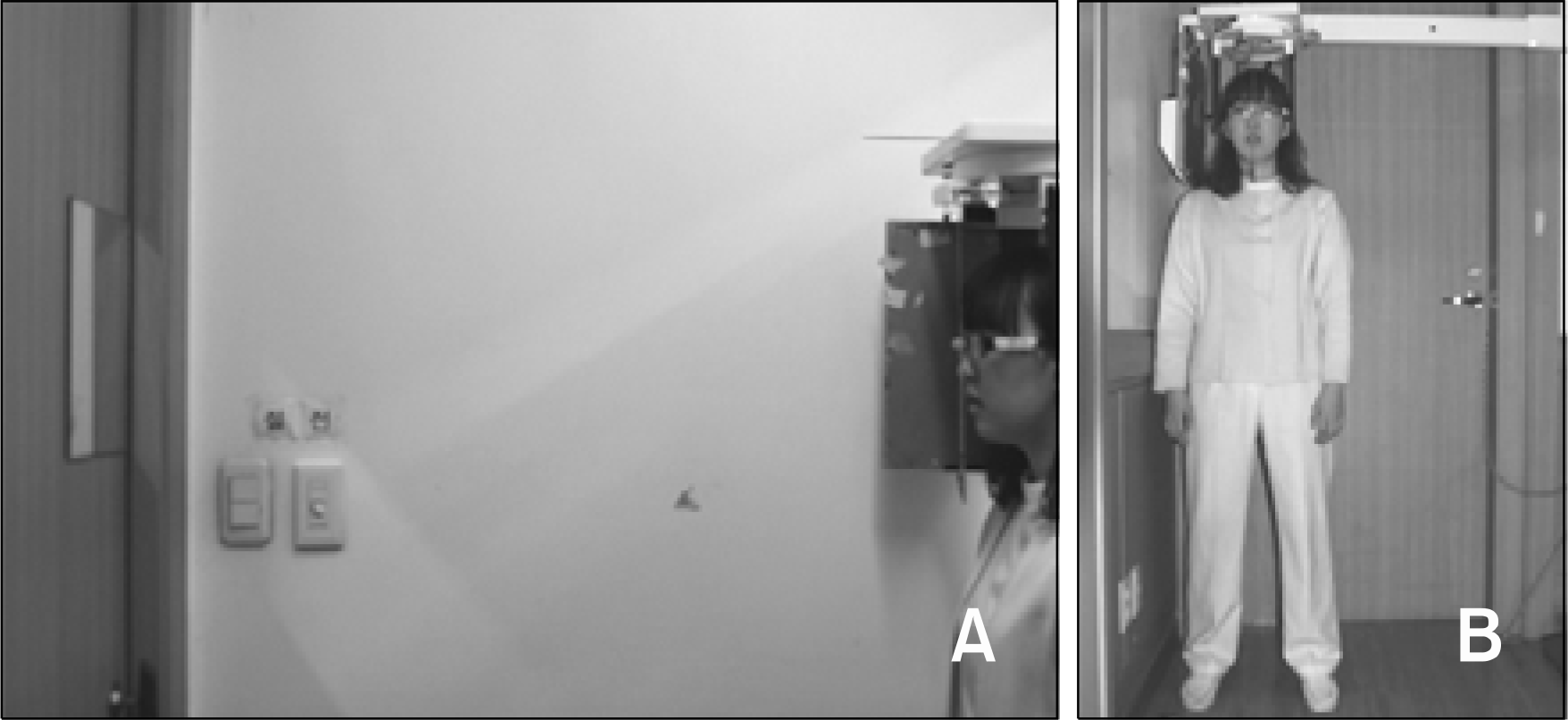 | Fig 2.Registration in the natural head position and lateral cephalogram. A, Subjects looked into their eyes in the mirror (orthoposition); B, standing position with arms and chin relaxed. |
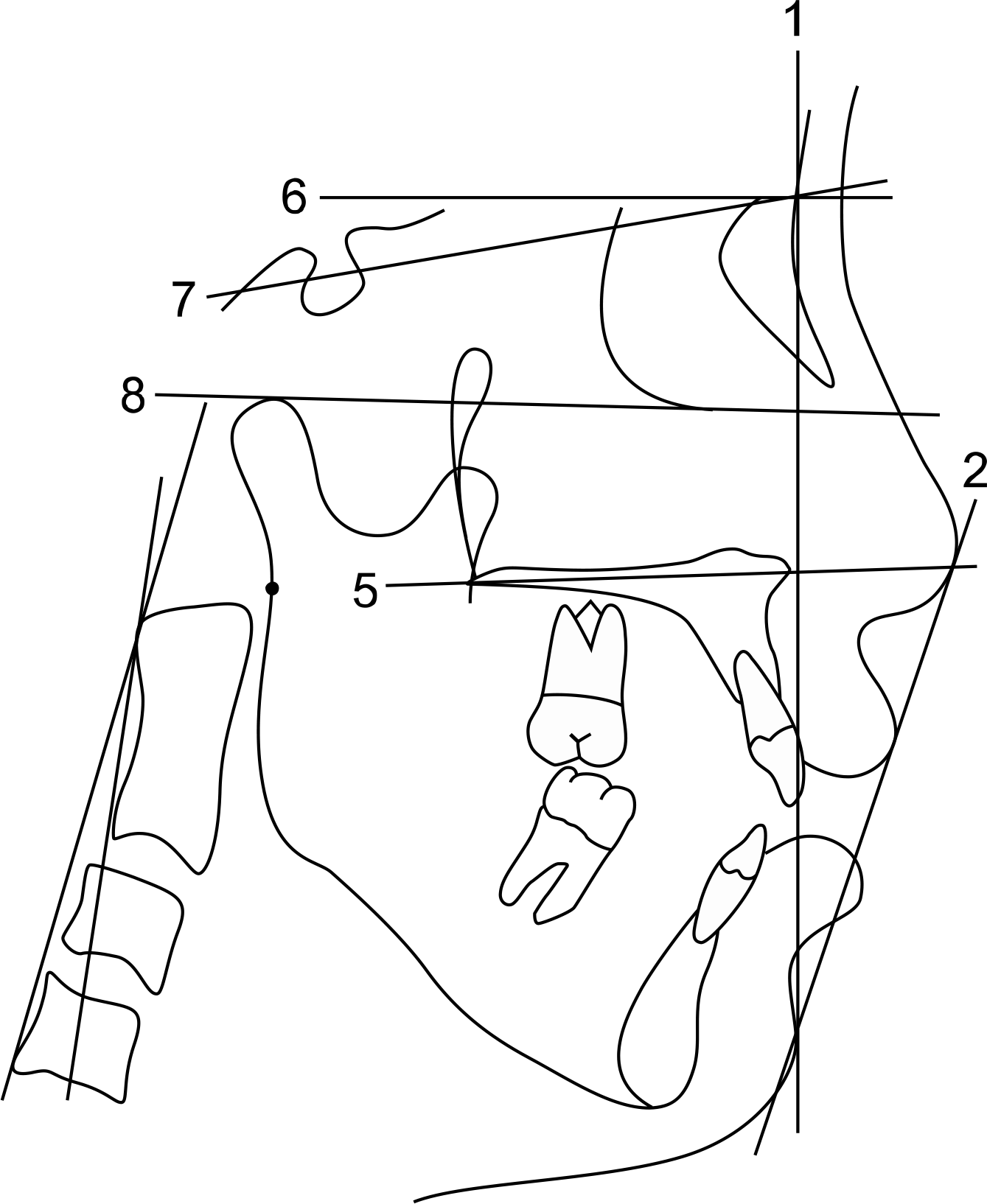 | Fig 4.Reference planes used in this study. 1, Nasion true vertical line (NTVL) passing through the nasion point perpendicular to the floor; 2, E-line, tip of nose-soft tissue pogonion; 3, cervical vertebrae tangent-plane the posterior tangent to the odontoid process through cv4ip; 4, odontoid process tangent plane, the posterior tangent to the odontoid process through cv2ip; 5, palatal plane, ANS-PNS; 6, true horizontal line passing through nasion point perpendicular to the NTVL; 7, sella-nasion plane; 8, Frankfurt horizontal plane, porion-orbitale. |
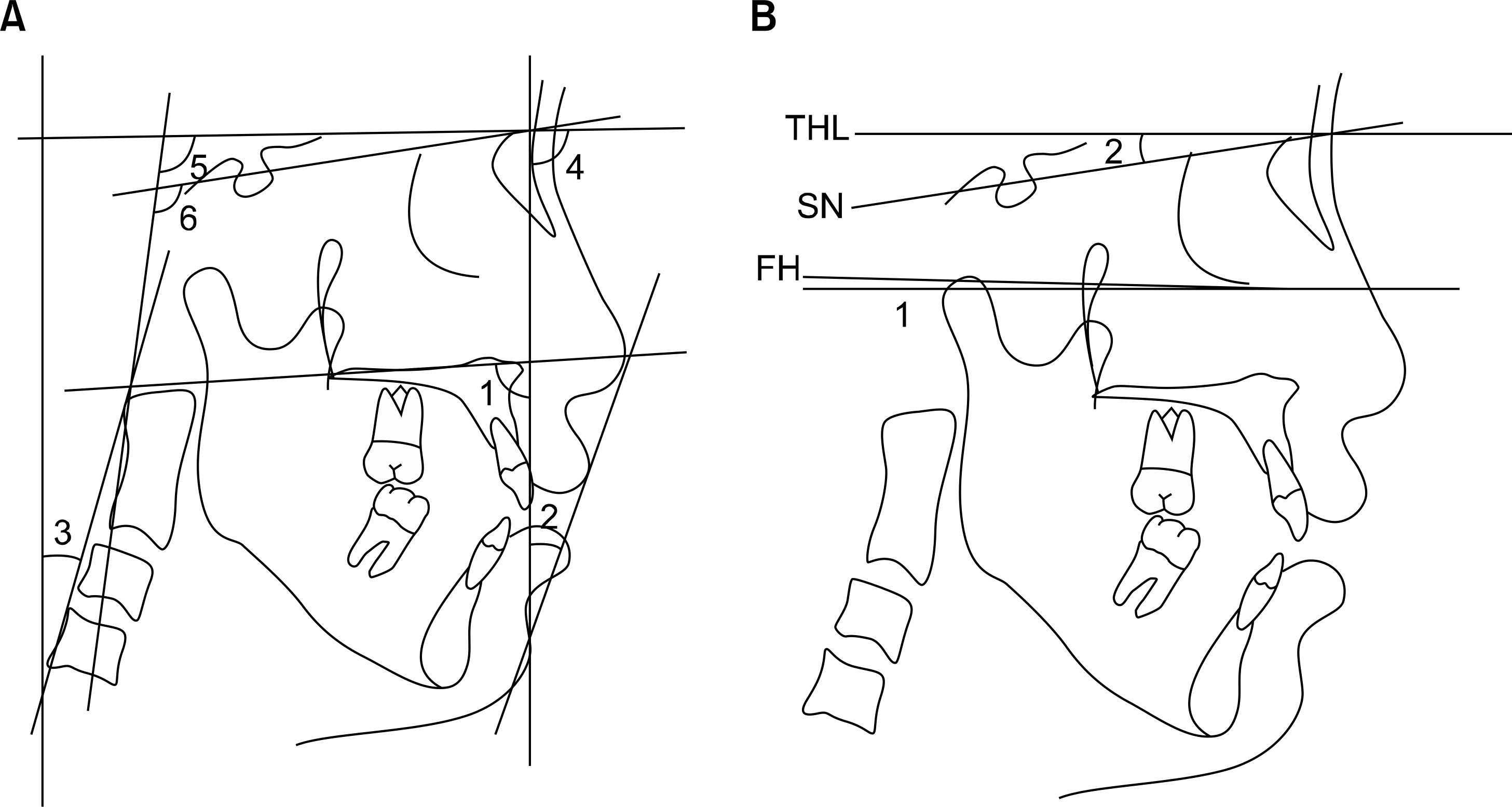 | Fig 5.Angular measurements. A, 1, Nasion true vertical line (NTVL) to palatal plane; 2, NTVL to E-Line; 3, NTVL to cervical vertebrae tangent; 4, NTVL to sella-nasion (SN); 5, true horizontal line (THL) to odontoid process tangent (OPT); 6, SN to OPT. B, 1, THL to Frankfurt horizontal plane; 2, THL to SN. |
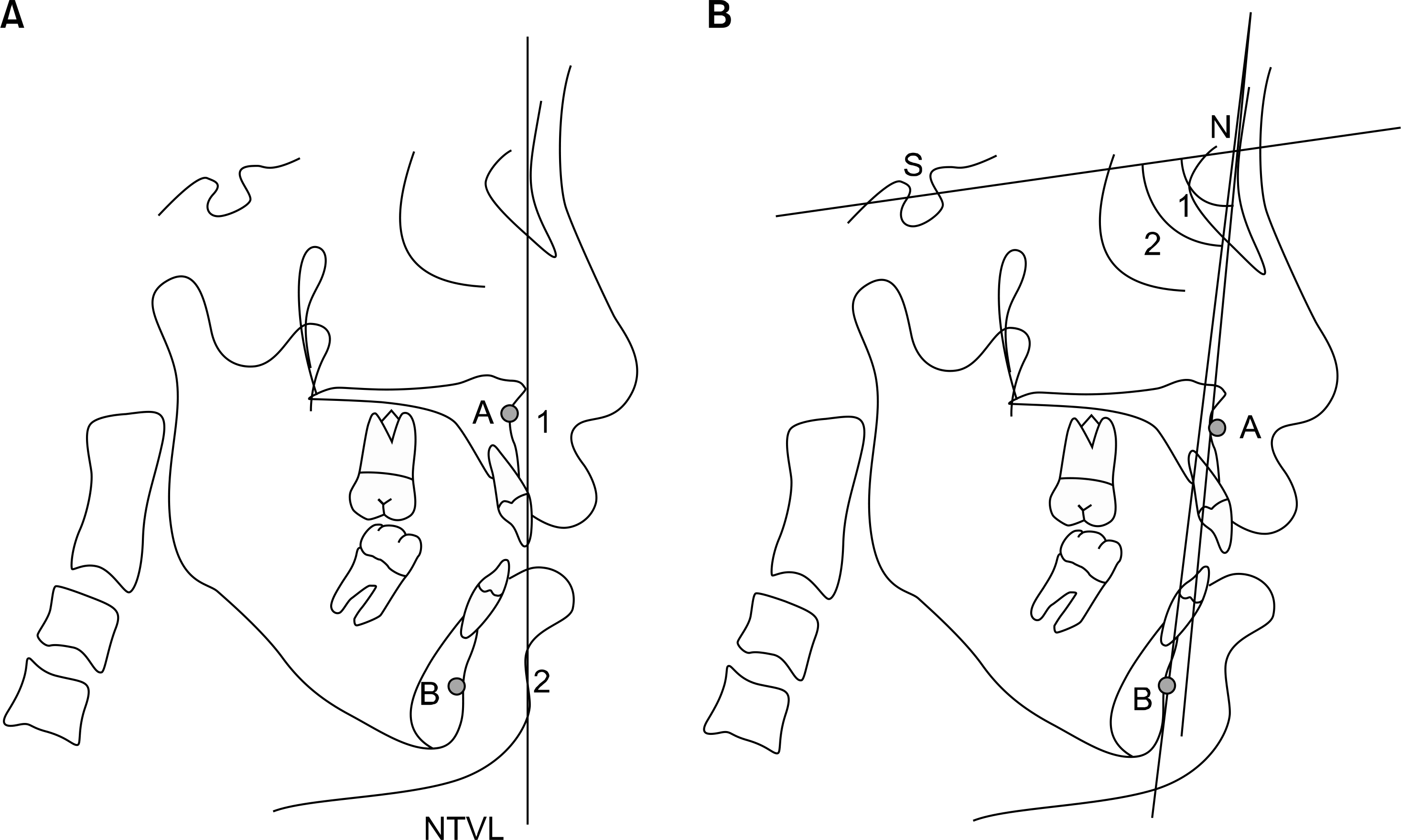 | Fig 6.Linear measurements. A, 1, Nasion true vertical line (NTVL to A-point); 2, NTVL to B-point. B, 1, Sella nasion A-point (SNA) angle; 2, sella nasion B-point (SNB) angle. |
Table 2.
Positioning method errors (n = 116)
| Variables | This study (n=116) | Huggare33 (n=33) | Solow & Tallgren19 (n=120) |
|---|---|---|---|
| SN/NTVL | 1.06 | 1.60 | 1.43 |
| SN/OPT | 1.28 | 1.35 | 1.43 |
| OPT/THL | 0.77 | 2.10 | 1.95 |
Table 3.
Reproducibility of natural head position (NHP by intraclass correlation coefficients (n = 116)
| Variables | Average of raters(α) | p-value |
|---|---|---|
| NTVL/E-line | 0.9925 | <0.001 |
| NTVL/palatalplane | 0.6102 | <0.001 |
| NTVL/CVT | 0.9883 | <0.001 |
| NTVL/SN | 0.9703 | <0.001 |
| SN/OPT | 0.9815 | <0.001 |
| NTVL/OPT | 0.9917 | <0.001 |
Table 4.
Differences in Frankfurt horizontal line (FHL) to true horizontal line (THL) and SN to true horizontal line compared to norms (n = 116)
| Variables | N | Mean | SD | Min | Max | p-value |
|---|---|---|---|---|---|---|
| THL/FH | 116 | −0.16 | 3.89 | −12.43 | 7.65 | <0.05 |
| THL/SN | 116 | 9.73 | 4.60 | −2.11 | 17.50 | <0.05 |
Table 5.
Correlations between linear measurements of A-point to nasion true vertical line (NTVL) and sella-naison (SN)-A angles, and linear measurements of B-point to NTVL and SN-B angles using Pearson correlation coefficients (n = 116)
| NTVLA | NTVLB | NTVLA1 | NTVLB1 | NTVLA2 | NTVLB2 | |
|---|---|---|---|---|---|---|
| SNA | 0.094 | |||||
| SNB | 0.314∗ | |||||
| SNA1 | 0.328∗ | |||||
| SNB1 | 0.314∗ | |||||
| SNA2 | 0.309∗ | |||||
| SNB2 | 0.287∗ |




 PDF
PDF ePub
ePub Citation
Citation Print
Print


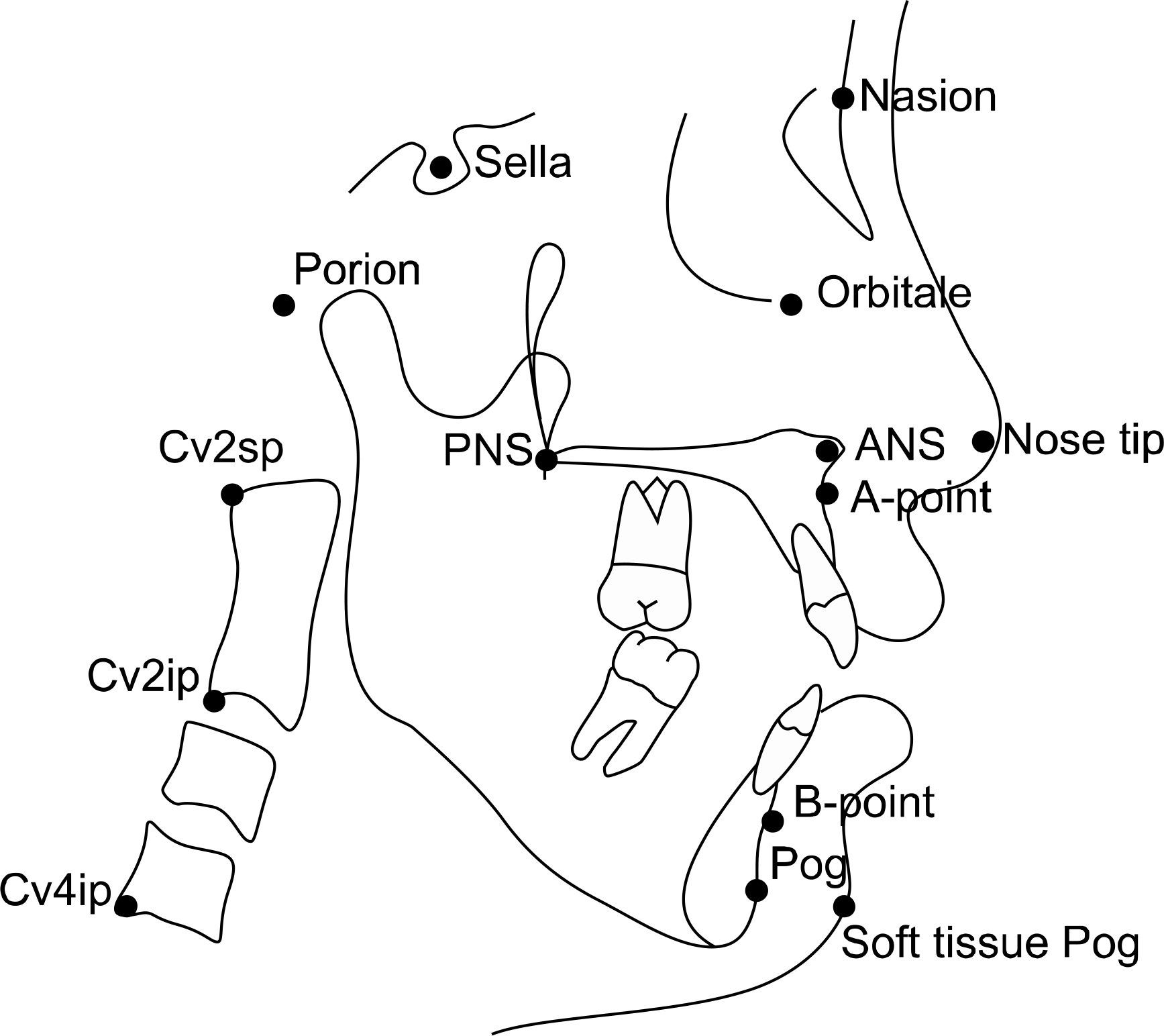
 XML Download
XML Download